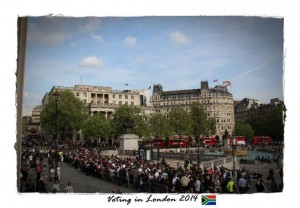
Everything You Need to Know for South Africa’s Elections
After the excitement of South Africans abroad voting last week, locals get their turn tomorrow to Make their Mark. Here are some answers in plain English for all those who may have questions about Election Day. Many of those who go to the polls tomorrow to vote for the first time will be too young to […]

After the excitement of South Africans abroad voting last week, locals get their turn tomorrow to Make their Mark. Here are some answers in plain English for all those who may have questions about Election Day.

Many of those who go to the polls tomorrow to vote for the first time will be too young to remember apartheid.
According to the Independent Electoral Commission (IEC), more young South Africans have registered to vote in this election than ever before – with 49.57% of registered voters under 40 years old.
The biggest segment of voters is those aged 30 to 39 (6.18-million), followed by 20- to 29-year-olds (5.7-million), the IEC says.
1. When and at what time can I vote?
- The elections are tomorrow, Wednesday 7 May 2014.
- Voting will take place from 07:00 to 21:00 (7 am to 9 pm). If you are still in the queue to vote at 9pm you must still be allowed to vote before the voting station closes.
2. Who can vote in the elections?
You can vote in the elections if:
- You are a citizen of South Africa
- You are 18 or older
- You have a green bar-coded ID book (you MUST take this along with you, or a smart ID card, or your temporary identity certificate)
- You are registered to vote in your voting district. This means your name and ID number are on the voters’ roll.
3. How do I check if I am registered to vote in the 2014 elections?
To check if you are registered to vote, and where your voting station is:
- Call 0800 11 8000 between 8am and 5pm, Monday to Friday (inside South Africa)
- Call +27 11 654 1000 (outside South Africa)
- Enter your ID number on the Electoral Commission’s My voter registration details web page
4. What will I be voting for?
You have two votes:
- You vote once in the national elections for the party of your choice to be represented in the National Assembly in parliament.
- Your second vote is in the provincial elections for the party of your choice to be represented in the legislature of your province.
5. What are my rights as a voter?
You have 10 rights as a voter:
- The right to free and fair elections
- The right to vote
- The right not to vote
- The right to spoil your vote
- The right to vote once in each election
- The right to your own free choice
- The right to a secret vote
- The right to get help to vote
- The right to vote safely
- The right to make a complaint
6. Where do I vote?
- You must vote at the voting station for the district in which you are registered.
- If you have voted in earlier elections, your voting station is probably at the same place you voted at before.
- If you registered to vote in November 2013 or February 2014, your voting station will be at the same place you registered.
- If you’re not sure where to vote, enter your ID number on the Electoral Commission’s My voter registration details web page. This will confirm whether you are registered to vote or not, and tell you where to vote.
- If you go to the wrong voting station, the voting officers there will tell you where your right voting station is.
- The IEC issued the final list of voting stations on 10 April.
7. What if my voting station is far away, and I don’t have transport?
- In a small number of voting districts, the Electoral Commission will send out mobile voting stations to reach voters in remote and sparsely populated areas. Even if you live far away from big cities, you still have the right to vote.
- You must vote in the voting district where you registered to vote.

8. How long will it take to vote?
- You should not spend too long in the queue as there are a fixed number of voters registered to vote at each voting station.
- If you are still in the queue at 21:00 (9 pm) at the end of election day, you must be allowed to vote before the voting station can close.
9. How do I vote ?
- You have to mark the ballot paper in a way that shows the party you want to vote for. You can do this by making a cross in the box next to the name of the party you support, or in another way that clearly indicates the party you are choosing.
- Make only one mark per ballot paper
- Your mark must not touch any of the walls/lines of the box. It’s best to make a cross.
10. What are the steps in the voting process?
- Entrance: When you get to the entrance of the voting station, the door controller will tell you when it is your turn to enter.
- ID Document: You will be directed to the voters’ roll table where IEC staff will look at your ID book or temporary ID certificate and check for your name on the voters’ roll.
If you are not on the voters’ roll, but have proof that you have registered, such as a registration sticker, the presiding officer must validate your proof of registration. If the officer is satisfied with the proof, you will have to complete a VEC4 form (national elections) or MEC7 form (municipal elections) and will then be allowed to continue as an ordinary voter. - Inked thumb: IEC staff will ink your left thumb. This is special ink that will not wash off for several days. It will show everyone you participated (and prevent people from voting more than once). Your ID book will also be stamped to show you have voted.
- Ballot paper: The voting officer will stamp the back of two official ballot papers (one for the national election; the other for the provincial election) and give them to you.
- Voting booth: You will be directed to an empty voting booth. You will be alone in a voting booth. Your vote is your secret. Here, you will place your X in the box next to the political party of your choice on both ballot papers. Your vote does not have to be the same. Fold your papers and leave the voting booth.
If you incorrectly mark a ballot paper and realise this before placing it in the ballot box, just ask the presiding officer for a new ballot paper. Make sure that the incorrect ballot paper is marked as “cancelled”. - Ballot box: Place your folded ballot papers into the right ballot box: one for national; the other for provincial votes. Once your ballot has been placed in the ballot box, it can’t be removed.
- Exit: Make your way to the exit. Security staff will be there to help you.

11. What if I make a mistake on my ballot paper?
- If you make a mistake on your ballot paper, you can get a new one from a voting officer.
- You can only get a new ballot paper if you notice the mistake before you put your vote into the ballot box.
- If you get a new ballot paper, your old ballot paper will be cancelled.
12. Am I allowed to take Selfies?
- You can take photographs outside the Voting Station, but it is a punishable offence to take photos of your marked ballot paper.
AFTER ELECTION DAY
How will the votes be counted?
- Counting will mostly happen at each voting station.
- Votes can be counted at a place other than at the voting station only with the approval of the IEC.
- Since the 2009 elections, there are improved controls over the record paper with the final results for a voting station. This has to be signed by the presiding officer and all political parties, and then scanned to create an immediate record and so more trust and openness in the process of compiling results.
Detailed Explantion of the counting process
- Verify: Accredited observers and party agents watch over the entire process, starting with the opening and emptying of the sealed ballot boxes.
- Unfold: Each ballot is unfolded and the back is checked for a stamp. Ballots without stamps are not counted.
- Sorted: The ballots are sorted into piles according to votes for each party. The counting officer must decide whether or not a questionable ballot paper (where it is not definitively clear which party has been voted for) should be counted or rejected. Party agents can dispute this.
- Count and bundle: The ballots are counted and bundled into packs of 100. The results are then tallied for each party.
- Reconcile and recount (if necessary): The results for the various parties are now reconciled against the total number of ballots. If the numbers do not match, there is a recount of all the votes.
- Sign results slips and seal ballots: Results are recorded on to a results system that has automated quality controls to ensure accuracy of results. Results slips are signed by the counting officer and the party agents and are scanned to allow political parties to compare against recorded results.
- Results centres: The results are posted on the door of the voting station and are also electronically sent to the national and nine provincial results centres where they are verified and collated. Independent external auditors audit this process.
- Final results: The final results and seat allocations for national and provincial legislatures are announced by the chief electoral officer – usually within seven days of the election.
How will the election results be worked out and announced?
- The overall election results will be worked out using a computer system at centralised venues under the control of the IEC.
- There will also be accredited observers and party agents at these venues to check that everything is done correctly and fairly.
- You can object against anything that happens during the elections that can affect the election results.
- You must make an objection before 17:00 on the second day after voting.
- The IEC will investigate your objection and can ask you to give evidence about the objection.
- The IEC will decide what to do about the objection. The IEC must make a decision within three days after receiving your objection.
- If you are not happy with the IEC’s decision, you can appeal to the Electoral Court within three days of the IEC’s decision.
- After all objections are dealt with, the IEC must announce the final results within seven days of Election Day. In practice, the IEC has managed to announce election results on the third day after Voting Day.
Contributed by: Mary Alexander & SouthAfrica.info
Source: Media Guide: National and Provincial Elections 2014
